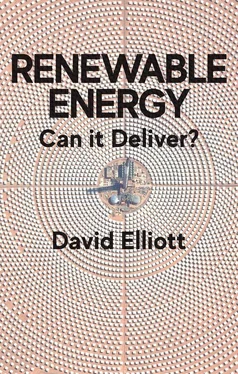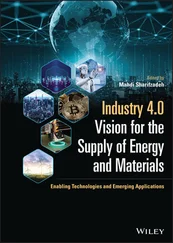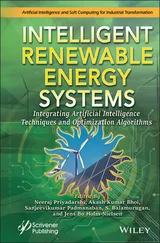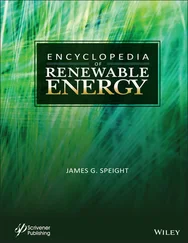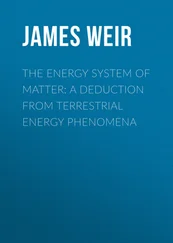134 125
135 126
136 127
137 128
138 129
139 130
140 131
141 132
142 133
143 134
144 135
145 136
146 137
147 138
148 139
149 140
150 141
151 142
152 143
153 144
154 145
155 146
156 147
157 148
158 149
159 150
160 151
161 152
162 153
163 154
164 155
165 156
166 157
167 158
168 159
169 160
170 161
171 162
172 163
173 164
174 165
175 166
176 167
177 168
178 169
179 170
180 171
181 172
182 173
183 174
184 175
185 176
186 177
187 178
188 179
189 180
190 181
191 182
192 183
193 184
194 185
195 186
196 187
197 188
198 189
199 190
200 191
201 192
202 193
203 194
204 195
205 196
206 197
207 198
208 199
209 200
210 201
211 202
212 203
213 204
214 205
215 206
216 207
217 208
218 209
219 210
220 211
221 212
222 213
223 214
224 215
225 216
226 217
227 218
228 219
229 220
230 221
231 222
232 223
233 224
234 225
235 226
236 227
237 228
238 229
239 230
240 231
241 232
To Godfrey Boyle, a friend, colleague and visionary, much missed
Renewable Energy
Can it Deliver?
David Elliott
polity
Copyright © David Elliott 2020
The right of David Elliott to be identified as Author of this Work has been asserted in accordance with the UK Copyright, Designs and Patents Act 1988.
First published in 2020 by Polity Press
Polity Press
65 Bridge Street
Cambridge CB2 1UR, UK
Polity Press
101 Station Landing
Suite 300
Medford, MA 02155, USA
All rights reserved. Except for the quotation of short passages for the purpose of criticism and review, no part of this publication may be reproduced, stored in a retrieval system or transmitted, in any form or by any means, electronic, mechanical, photocopying, recording or otherwise, without the prior permission of the publisher.
ISBN-13: 978-1-5095-4163-8
ISBN-13: 978-1-5095-4164-5 (pb)
A catalogue record for this book is available from the British Library.
Library of Congress Cataloging-in-Publication Data
Names: Elliott, David, 1943- author.
Title: Renewable energy : can it deliver? / David Elliott.
Description: Cambridge, UK ; Medford, MA, USA : Polity, 2020. | Includes bibliographical references and index. | Summary: “An incisive introduction to renewable energy and its global expansion”-- Provided by publisher.
Identifiers: LCCN 2019052504 (print) | LCCN 2019052505 (ebook) | ISBN 9781509541638 | ISBN 9781509541645 (pb) | ISBN 9781509541652 (epub)
Subjects: LCSH: Renewable energy sources.
Classification: LCC TJ808 .E453 2020 (print) | LCC TJ808 (ebook) | DDC 333.79/4--dc23
LC record available at https://lccn.loc.gov/2019052504
LC ebook record available at https://lccn.loc.gov/2019052505
The publisher has used its best endeavours to ensure that the URLs for external websites referred to in this book are correct and active at the time of going to press. However, the publisher has no responsibility for the websites and can make no guarantee that a site will remain live or that the content is or will remain appropriate.
Every effort has been made to trace all copyright holders, but if any have been overlooked the publisher will be pleased to include any necessary credits in any subsequent reprint or edition.
For further information on Polity, visit our website: politybooks.com
Thanks for some criticism, advice and input from Tam Dougan, editor of the long-running Renew newsletter, previously based at the Open University and now run independently.
BECCSbioenergy with carbon capture and storageBECCUbioenergy with carbon capture and utilizationCCScarbon capture and storageCCUcarbon capture and utilizationCHPcombined heat and powerCO2carbon dioxideCSPconcentrated solar powerDACSdirect air capture and storageEROEIenergy return on energy investedGDPgross domestic productIEAInternational Energy AgencyIRENAInternational Renewable Energy AgencyLNGliquid natural gasLUT/EWGLappeenranta University of Technology/Energy Watch GroupNETnegative emissions technologyNGOnon-governmental organizationP2Gpower-to-gasPVphotovoltaic solar powerREN21Renewable Energy Network for the 21st CenturyWECWorld Energy Council
The use of renewable energy is spreading rapidly, and some claim that wind, solar and other renewables can and will become the dominant global energy sources within a few decades, thus avoiding major climate change problems. Concerns about climate change have been a key driver, leading to growing government support. However, the falling cost of renewable energy has also become a major driver. Some renewable energy technologies are now competitive across the board and costs continue to fall, with a new commercial dynamic adding impetus to their uptake. This book asks whether that trend will be sufficient to ensure that renewables expand fast enough globally to limit climate change to survivable levels without imposing high costs.
There are certainly many who doubt that this is possible. Some critics argue that renewable energy systems are inherently unreliable and expensive, and they look to nuclear power as an alternative non-fossil option, and possibly also to cleaning up fossil fuel use. This book seeks to meet these claims head on and asks to what extent renewables can deliver a technologically and economically viable energy future, and whether other technical options and energy policies to support them are also needed. It explores how important renewable energy technology might be by looking at its progress so far and at its future potential and problems in a context where other approaches are also on offer. Much has been promised from renewables and, so far, they seem to be living up to the promises as they accelerate ahead. This book looks at whether that can and will continue.
1 Introduction: All Change?
Renewables are no longer marginal but have become mainstream. This introductory chapter asks what has driven their recent success – and can it continue?
The dynamics of technological change
The way in which we have used technology to meet energy needs in the past has been a key cause of many environmental problems, including air pollution and climate change, but new technology, and new patterns of development based on it, may offer possible solutions to some of these problems. That said, while there is a strong case for looking at technology as a key factor in the attempt to move towards a more environmentally sustainable global future, technology is only one factor and possibly not the leading one. We may also need social and economic change.
However, there are interactive processes at work. The development and adoption of new technology is usually driven by social and economic forces, including profit. Environmental issues have also increasingly come to the fore and are having a direct effect. For example, climate concerns have been a stimulus for rapid recent renewable energy growth, along with air pollution issues, notably bad of late in some Asian cities. Something had to be done, and a switch to cleaner technologies was one option.
Читать дальше
